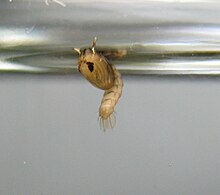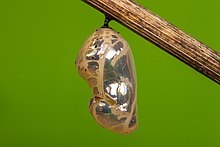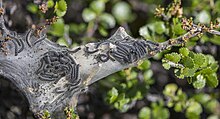Pupa


Apupa(fromLatinpupa'doll';pl.:pupae) is the life stage of someinsectsundergoing transformation between immature and mature stages. Insects that go through a pupal stage areholometabolous:they go through four distinct stages in their life cycle, the stages thereof being egg,larva,pupa, andimago.The processes of entering and completing the pupal stage are controlled by the insect's hormones, especiallyjuvenile hormone,prothoracicotropic hormone,andecdysone.The act of becoming a pupa is called pupation, and the act of emerging from the pupal case is called eclosion or emergence.
The pupae of different groups of insects have different names such aschrysalisfor the pupae ofbutterfliesandtumblerfor those of themosquitofamily. Pupae may further be enclosed in other structures such ascocoons,nests,orshells.[1]
Position in life cycle
[edit]The pupal stage follows thelarvalstage, or in some cases aprepupalstage, and precedesadulthood(imago) in insects with complete metamorphosis. The pupa is a non-feeding, usuallysessilestage, or highly active as in mosquitoes. It is during the pupal stage that the adult structures of the insect are formed while the larval structures are broken down. The adult structures grow fromimaginal discs.[2]
Duration
[edit]The pupal stage may last weeks, months, or even years, depending on temperature and the species of insect.[3][4]For example, the pupal stage lasts eight to fifteen days inmonarch butterflies.[5]The pupa may enterdormancyordiapauseuntil the appropriate season to emerge as an adult insect. Intemperateclimates pupae usually stay dormant during winter, while in thetropicspupae usually do so during thedry season.

Emergence
[edit]Insects emerge (eclose) from pupae by splitting the pupal case. Most butterflies emerge in the morning. In mosquitoes, the emergence is in the evening or night. In fleas, the process is triggered by vibrations that indicate the possible presence of a suitable host. Prior to emergence, the adult inside the pupalexoskeletonis termedpharate.Once the pharate adult has eclosed from the pupa, the empty pupal exoskeleton is called anexuvia;in mosthymenopterans(ants, bees and wasps) the exuvia is so thin and membranous that it becomes "crumpled" as it is shed. Measuring the timing of this emergence is of interest to chronobiologists because the process is regulated bycircadian clocksin many species, necessitating differentassaysto measure eclosion timing.
Pupal mating
[edit]
In a few taxa of the Lepidoptera, especiallyHeliconius,pupal mating is an extreme form of reproductive strategy in which the adult male mates with a female pupa about to emerge, or with the newly moulted female; this is accompanied by other actions such as capping of the reproductive system of the female with thesphragis,denying access to other males, or by exuding an anti-aphrodisiac pheromone.[6][7]
Defense
[edit]Pupae are usually immobile and are largely defenseless. To overcome this, pupae often are covered with a cocoon, conceal themselves in the environment, or form underground.[8]Some species ofLycaenid butterfliesare protected in their pupal stage by ants. Another means of defense by pupae of other species is the capability of making sounds or vibrations to scare potential predators. A few species use chemical defenses including toxic secretions. The pupae of socialhymenopteransare protected by adult members of the hive.
Types
[edit]Based on the presence or absence of articulatedmandiblesthat are employed in emerging from a cocoon or pupal case, the pupae can be classified in to two types:[9]
- Decticous pupa– a pupa with articulated mandibles. Examples are pupae of the ordersNeuroptera,Mecoptera,Trichopteraand fewLepidopterafamilies.
- Adecticous pupa– a pupa without articulated mandibles. Examples include the ordersStrepsiptera,Coleoptera,Hymenoptera,DipteraandSiphonaptera.
Based on whether the pupal appendages are free or attached to the body, the pupae can be classified as one of three types:
- Exarate pupa– appendages are free and are not usually encapsulated within a cocoon. Decticous pupae are always exarate; some adecticous pupae are as well. (Neuroptera, Trichoptera,Cyclorrhaphaof Dipterans, Siphonaptera, most Coleoptera, Hymenoptera, and few Lepidoptera).
- Obtect pupa– appendages are attached closely to the body and are commonly encapsulated within a cocoon. Some adecticous pupa are obtect forms. (Most Lepidoptera,NematoceraandBrachyceraof Dipterans,StaphylinidaeandChrysomelidaeColeopterans, manyChalcidoideaHymenopterans)
- Coarctate pupa– enclosed in a hardened cuticle of the penultimate larval instar called a puparium. However, the pupa itself is of the exarate adecticous pupal form. (Cyclorrhapha of Dipterans).
Chrysalis
[edit]
A chrysalis (Latin:chrysallis,fromAncient Greek:χρυσαλλίς,chrysallís,plural:chrysalides,also known as anaurelia) or nympha is the pupal stage ofbutterflies.The term is derived from the metallic–gold coloration found in the pupae of many butterflies, referred to by the Ancient Greek termχρυσός(chrysós) for gold.
When the caterpillar is fully grown, it makes a button of silk which it uses to fasten its body to a leaf or a twig. Then the caterpillar's skin comes off for the final time. Under this old skin is a hard skin called a chrysalis.[10]
Because chrysalises are often showy and are formed in the open, they are the most familiar examples of pupae. Most chrysalides are attached to a surface by aVelcro-like arrangement of asilkenpad spun by thecaterpillar,usually cemented to the underside of a perch, and thecremastralhook or hooks protruding from the rear of the chrysalis orcremasterat the tip of the pupalabdomenby which the caterpillar fixes itself to the pad of silk. (Gr.kremastos'suspended')[11]
Like other types of pupae, the chrysalis stage in most butterflies is one in which there is little movement. However, some butterfly pupae are capable of moving the abdominal segments to produce sounds or to scare away potentialpredators.Within the chrysalis, growth and differentiation occur.[12]The adult butterfly emerges (ecloses) from this and expands its wings by pumpinghaemolymphinto the wing veins.[13]Although this sudden and rapid change from pupa to imago is often calledmetamorphosis,metamorphosis is really the whole series of changes that an insect undergoes from egg to adult.
When emerging, the butterfly uses a liquid, sometimes calledcocoonase,which softens the shell of the chrysalis. Additionally, it uses two sharp claws located on the thick joints at the base of the forewings to help make its way out.[14]Having emerged from the chrysalis, the butterfly will usually sit on the empty shell in order to expand and harden its wings. However, if the chrysalis was near the ground (such as if it fell off from its silk pad), the butterfly would find another vertical surface to rest upon and harden its wings (such as a wall or fence).
Mothpupae are usually dark in color and either formed in underground cells, loose in the soil, or their pupa is contained in a protectivesilkcase called acocoon.The pupa of some species such as thehornet mothdevelops sharp ridges around the outside called adminicula that allow the pupa to move from its place of concealment inside a tree trunk when it is time for the adult to emerge.[15]
Pupa, chrysalis, and cocoon are frequently confused, but are quite distinct from each other. The pupa is the stage between the larva and adult stages. The chrysalis generally refers to a butterfly pupa although the term may be misleading as there are some moths whose pupae resembles a chrysalis, e.g.: the plume winged moths of the familyPterophoridaeand somegeometridmoths. A cocoon is a silk case that the larvae of moths, and sometimes other insects, spin around the pupa.
Cocoon
[edit]
A cocoon is a casing spun ofsilkby manymothsandcaterpillars,[16]and numerous otherholometabolousinsectlarvaeas a protective covering for the pupa.
Cocoons may be tough or soft, opaque or translucent, solid or meshlike, of various colors, or composed of multiple layers, depending on the type of insect larva producing it. Many moth caterpillars shed the larval hairs (setae) and incorporate them into the cocoon; if these areurticating hairsthen the cocoon is also irritating to the touch. Some larvae attach small twigs, fecal pellets or pieces of vegetation to the outside of their cocoon in an attempt to disguise it from predators. Others spin their cocoon in a concealed location—on the underside of aleaf,in acrevice,down near the base of atree trunk,suspended from a twig or concealed in theleaf litter.[17]Contrary to popular belief, larvae do not completely liquify inside the cocoon.[18]

The silk in the cocoon of thesilk mothcan be unraveled to harvest silk fibre which makes this moth the most economically important of all lepidopterans. The silk moth is the only completely domesticated lepidopteran; it does not exist in the wild.
Insects that pupate in a cocoon must escape from it, and they do this either by the pupa cutting its way out, or by secretingenzymes,sometimes calledcocoonase,that soften the cocoon. Some cocoons are constructed with built-in lines of weakness along which they will tear easily from inside, or with exit holes that only allow a one-way passage out; such features facilitate the escape of the adult insect after it emerges from the pupal skin.
Puparium
[edit]
Some pupae remain inside the exoskeleton of the final larvalinstarand this last larval "shell" is called a puparium (plural, puparia). Flies of the groupMuscomorphahave puparia, as do members of the orderStrepsiptera,and theHemipteranfamilyAleyrodidae.[19]
Gallery
[edit]-
Fruit fly (Drosophila melanogaster) pupa
-
Anemperor gum mothcaterpillar spinning its cocoon
-
Luna mothcocoon and pupa
-
Assortment of luna moth cocoons
-
Luna moth emerging from pupa withinsilk cocoon
-
Luna moth pupa removed from cocoon
-
Chrysalis ofGulf fritillary
-
Pupation ofAglais io
-
Monarch butterflychrysalis
-
Specimen of an eclosingDryas iuliabutterfly
-
Pupa ofcabbage looper
-
Pupa of baron butterflyEuthalia aconthea
-
Papilio polytescommon Mormon pupa on curry leaves.
-
Dog-day cicadaemerging
See also
[edit]References
[edit]- ^Borror, D. J.; DeLong, Dwight M.; Triplehorn, Charles A. (2004).Introduction to the Study of Insects(Sixth ed.). New York: Holt, Rinehart & Winston.ISBN0-03-096835-6.
- ^Aldaz, Silvia; Escudero, Luis M. (2010)."Imaginal discs".Current Biology.20(10): R429–R431.Bibcode:2010CBio...20.R429A.doi:10.1016/j.cub.2010.03.010.PMID20504747.
- ^Nielsen, Erik Tetens, and J. St Haeger. "Pupation and emergence inAedes taeniorhynchus(Wied.). "Bulletin of Entomological Research45.4 (1954): 757–768.
- ^Elliott, J. M. "Temperature‐related fluctuations in the timing of emergence and pupation of Windermere alder‐flies over 30 years."Ecological Entomology21.3 (1996): 241–247.
- ^University of Minnesota Extension, Monarch Lab."Monarch Life Cycle".Archived fromthe originalon 7 July 2018.Retrieved20 September2017.
- ^Preston–Mafham, Rod; Preston–Mafham, Ken (1993).The Encyclopedia of Land Invertebrate Behaviour(Illustrated ed.). MIT Press. p.113.ISBN978-0-262-16137-4.Retrieved16 November2010.
- ^Boggs, Carol L.; Watt, Ward B.; Ehrlich, Paul R. (2003).Butterflies: Ecology and Evolution Taking Flight(Illustrated ed.). University of Chicago Press. p. 739.ISBN978-0-226-06318-8.Retrieved16 November2010.
- ^Chapman, R. F. (Reginald Frederick) (2013).The insects: structure and function.Cambridge University Press. p. 419.ISBN978-0-521-11389-2.OCLC794624696.
- ^"Types of Pupa".Agri Info. Archived fromthe originalon 4 February 2017.Retrieved28 April2016.
- ^Darby, Gene (1958).What is a Butterfly.Chicago:Benefic Press.p.19.
- ^"Academic Dictionaries and Encyclopedias".Archivedfrom the original on 2013-05-25.Retrieved2013-01-20.
- ^Lowe, Tristan; Garwood, Russell P.; Simonsen, Thomas; Bradley, Robert S.; Withers, Philip J. (2013)."Metamorphosis revealed: three dimensional imaging inside a living chrysalis".Journal of the Royal Society Interface.10(84). 20130304.doi:10.1098/rsif.2013.0304.PMC3673169.PMID23676900.
- ^AMNHArchivedDecember 7, 2006, at theWayback MachineAccessed December 2006
- ^The Entomologist
- ^Newland, D.E. "Eclosion mechanics, mating and ovipositing behaviour ofSesia apiformis".Entomologist's Gazette.
- ^Darby, Gene (1958).What is a Butterfly.Chicago: Benefic Press. p. 41.
- ^Scoble, Malcolm J. (1992).The Lepidoptera: Form, Function and Diversity.Oxford: Oxford University Press.ISBN0-19-854031-0.
- ^Guarino, Ben (September 19, 2017)."Mutant butterflies reveal the genetic roots of colorful wings".The Washington Post.Archivedfrom the original on September 19, 2017.RetrievedJuly 6,2024.
- ^Gullan, P. J.; Cranston, P. S. (2000).The Insects: An Outline of Entomology(2nd ed.). London: Blackwell.ISBN0-632-05343-7.
External links
[edit]- Pupa photosplus species descriptions atInsecta.pro
- Silk worm life cycle photos(archived 8 November 2012)
















